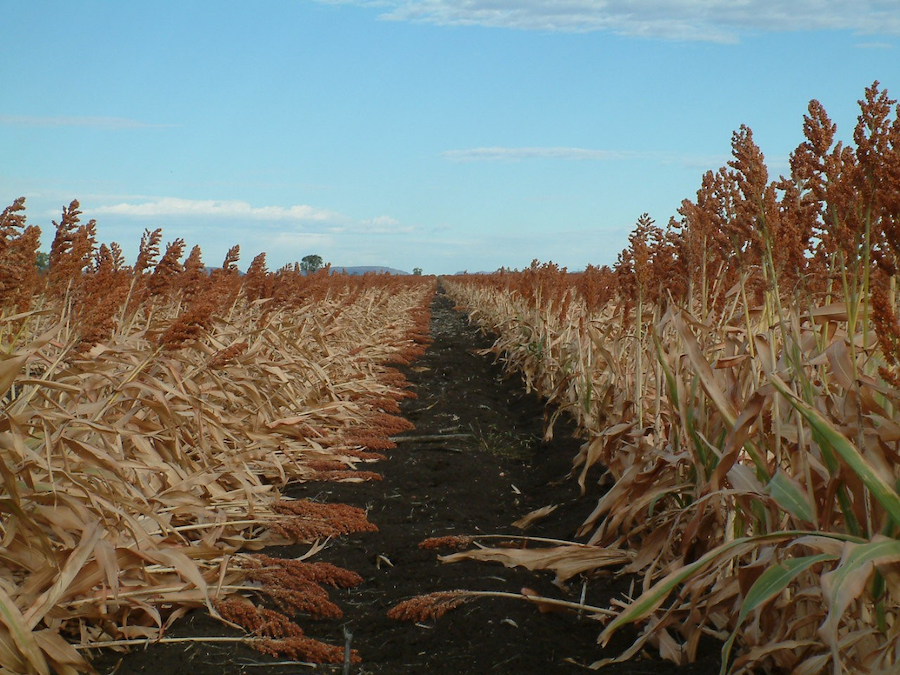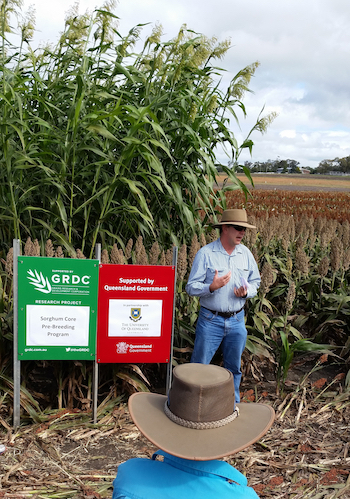Lodging has been a major problem for the sorghum industry since the introduction of high-yielding hybrids in the 1960s. The problem is especially damaging since lodging tends to affect crops with high yield potential, causing them to fall over in response to environmental conditions associated with terminal droughts.
With the problem persisting despite breeding efforts to reduce lodging susceptibility, researchers at the Queensland Alliance for Agriculture and Food Innovation (QAAFI) and their partners at the Department of Agriculture and Fisheries (DAF) have taken a new approach.
PhD student Xuemin Wang, supervised by Professor David Jordan and Dr Emma Mace, has applied genome-wide association mapping tools to detect regions in the sorghum genome where variation in DNA sequence associates with variation in lodging susceptibility. The work has received GRDC investment.
The genetic map has resulted in new insights and genetic tools that allow for novel and more strategic approaches to breeding lodging resistance into sorghum hybrids.
Lodging

A novel genetic map has pointed the way to improving sorghum’s resistance to lodging without imposing negative impacts on yield potential. Shown is a skip row sorghum lodge at Springsure, Queensland. Photo: QAAFI
Professor Graeme Hammer, another team member, says research found that lodging is triggered by water scarcity when it induces the plant to stop photosynthesis and a shift to using carbohydrates stored in the stems. This shift weakens the stems, culminating in their death and possible invasion by pathogens, such as Fusarium, which further weakens the stems.
“With the right environmental conditions, crop losses can be as high as 100 per cent of an otherwise high-yielding crop,” Professor Jordan explains. “Overall, we are seeing about 10 per cent of crops in any one year affected by lodging.”
Research undertaken by QAAFI defined the extent of the problem caused by lodging. The study used a dataset of 83 trials from the University of Queensland/DAF pre-breeding program, which were undertaken in the seven major sorghum production environments in Australia over 14 seasons.
Each trial contained large numbers of experimental hybrids and the majority of the commercial hybrids sold in that year.
The study found that lodging occurred in all production regions, but with varying frequency and severity. Lodging was significantly greater in regions that were more prone to water stress (such as the Central Highlands in Queensland) and significantly lower in regions that were less likely to suffer from water stress (such as the Liverpool Plains in northern New South Wales) compared to the overall average across regions.
Over the 14 growing seasons, the frequency of lodging varied from zero to 100 per cent, with the most severe lodging (greater than 20 per cent) observed in 2005, 2016 and 2017. The Southern Oscillation Index was found to explain 29 per cent of the seasonal variation in lodging frequency.
“The study clearly supports a link between lodging incidence and water stress across regions and seasons,” DAF’s Alan Cruickshank says. “Our data also found that, despite substantial turnover of commercial hybrids during the study period, the level of resistance to lodging appeared not to have improved.”
The lodging/yield relationship
 Field trials helped to elucidate the combination of environmental and genetic factors that elevate the risk of sorghum crops lodging. Photo: QAAFI
Field trials helped to elucidate the combination of environmental and genetic factors that elevate the risk of sorghum crops lodging. Photo: QAAFI
The reason for stagnating gains in lodging resistance has been identified. It is due to an inverse relationship to yield potential: “The higher the yield potential of a sorghum line, the more likely it is to suffer from lodging,” Professor Jordan says. “Breeders are improving both traits, but trading-off lodging resistance to increase yield.”
To get over this impasse, the QAAFI–DAF sorghum pre-breeding team undertook one of the largest genome-wide association studies in sorghum in the world. This study involved 2308 unique hybrids grown in 17 Australian sorghum trials over three years.
The mapping revealed that lodging is a very complex trait in sorghum and implicated about 213 regions of the genome. That means variation in many genes is able to cause variation in lodging characteristics.
“A genome-wide view of the genetics is especially important going forward,” Professor Jordan says. “It means we can discriminate among all the network of lodging-associated genes for those pathways that are unlikely to negatively impact yields.”
For example, plant height was found to correlate with lodging sensitivity. However, it is also associated with high yield potential. So, this is an example of a trait that the researchers want to avoid using as a tool to improve lodging resistance.
Instead, much more scope for genetic gain without adverse yield impacts seems likely by targeting other plant traits. High on the list are greater stem strength (achieved through altered stem composition) and disease resistance. Professor Jordan expects that two breeding strategies can be used to make genetic gains in these kinds of genes. These encompass:
- tapping naturally occurring variation in stem-strength genetics within the broader sorghum gene pool; and
- targeting changes to suitable stem-strength genes using versions of gene-editing technology that are designated as ‘non-GM’.
“As we come to grips with having an overview of the genetics that underlie lodging in sorghum, we are looking at ways to use both strategies to improve lodging resistance,” Professor Jordan says. “Particularly attractive are genes involved in the biosynthesis of lignin, which is a woody molecule used as scaffolding in plant cell walls.”
One approach would involve screening genetically diverse sorghum collections for variation in the lignin biosynthesis genes. Screening could be accelerated through the use of hyperspectral cameras that use near-infrared light to measure the lignin content of stems.
The overall aim is to build on gains in lodging resistance achieved through the deployment of stay-green genes that delay the shutdown of photosynthesis and stem death that triggers lodging in sorghum.
“We are at the point where we have come as far as we can with the stay-green mechanism for reducing the incidence of lodging,” Professor Jordan says. “By generating the new genetic map, we can now identify new leads for breeding greater lodging resistance into high-yielding sorghum hybrids.”
More information: David Jordan, David.jordan@daf.qld.gov.au

























































